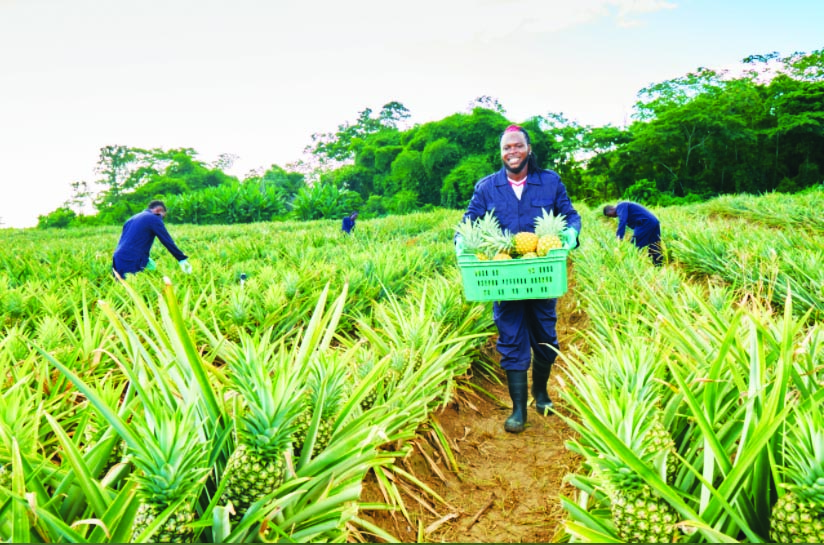There may well be an important lesson for Guyana and the rest of the region to learn from the recent news that Jamaica’s pineapple farmers have secured a breakthrough which now allows them to export their produce to Barbados.
Late last month the Ministry of Agriculture and Fisheries in Kingston disclosed that a bilateral agreement had been reached clearing the way for pineapples from Jamaica to be imported into Barbados.
The breakthrough can be a bigger ‘deal’ for Jamaica than appears to be the case on the surface. Barbados is one of the high-profile Caribbean territories for tourists from around the world and pineapple is known to be among the more popular fruit consumed by visitors to the island.
For the region the agreement between Jamaica and Barbados may also signal a modest but important breakthrough for intra-regional trade in agricultural commodities, a goal which has, for various reasons, eluded it.
The procedures associated with the breakthrough pineapple export deal between the two CARICOM countries include the requirement that Jamaican farmers wishing to have access to the Barbados pineapple market secure compliance with Jamaica’s plant quarantine regulations which include inspection procedures associated with phytosanitary requirements. Import permits from the Plant Quarantine Division of the Ministry of Agriculture and Food Security in Barbados will also have to be secured by the Jamaican farmers seeking to access the Barbados pineapple market.
The breakthrough for Jamaica’s pineapple farmers is an important development for the country’s agricultural sector which has, over time, been seeking to ‘raise its game’ in pursuit of increasing the country’s earnings from farm produce.
In Europe, Jamaica has recently made an important farm produce export breakthrough, securing clearance from the authorities in the United Kingdom to export pineapples, coconuts, citrus, cotton, bananas, apples, plums, papaya and guava to that country.
What is noteworthy about the progress being made by Jamaica in expanding both intra-regional and extra-regional markets for its exports is the striking contrast between that country’s individual breakthroughs and the pointed failures of CARICOM member countries as a whole to take their intra-regional trade in farm produce to a higher level.
The early October intervention by Guyana’s President Dr. Irfaan Ali in a presentation made to mark Caribbean Week of Agriculture (CWA) asserting that, Guyana will be intensifying its advocacy for the elimination of intra-regional trade barriers, was intended to underscore, particularly, trade barriers that have continually retarded intra-regional trade in agricultural goods. Listed among the barriers cited by the Guyanese President were non-tariff barriers including quotas, embargoes, sanctions and levies that affect some exports to CARICOM markets. At the same time President Ali, like most of his predecessors, sought to promote Guyana’s credentials to spearhead large-scale intra-regional agricultural investments on account of the country’s size and the credentials of its agricultural sector.
“The Caribbean has a means of securing greater self-sufficiency in food but much more needs to be done in ensuring in particular that the wheels of intra-regional trade are not encumbered,” is what the Guyanese President is quoted as having said in his CWA address.
What the history of the region’s largely failed efforts to create structures that can both bolster intra-regional trade in agricultural goods and make a greater impact on external markets has proven, however, is that those efforts need to go far beyond high-sounding verbal commitments and the feeble diplomatic efforts that have been undertaken so far, if these goals are to be achieved. Contextually, there has been, over the years, no shortage of highly publicized verbal commitments from Heads of Government and Ministers of Agriculture within the Community that have come to nothing.
It is the repeated bilateral and region-wide failures to create a more convivial regime for intra-regional trade in agricultural goods and equally significantly to secure key market opportunities outside the region that raises questions as to why most of the rest of the region have failed to achieve this goal. Perhaps it has to do with the fact that as a region we are yet to fashion, collectively, the will to disentangle from the ceaseless rhetoric which is the key to taking the process forward.
In this particular regard there may well be a strong case for looking more closely at the pursuits of Jamaica.






